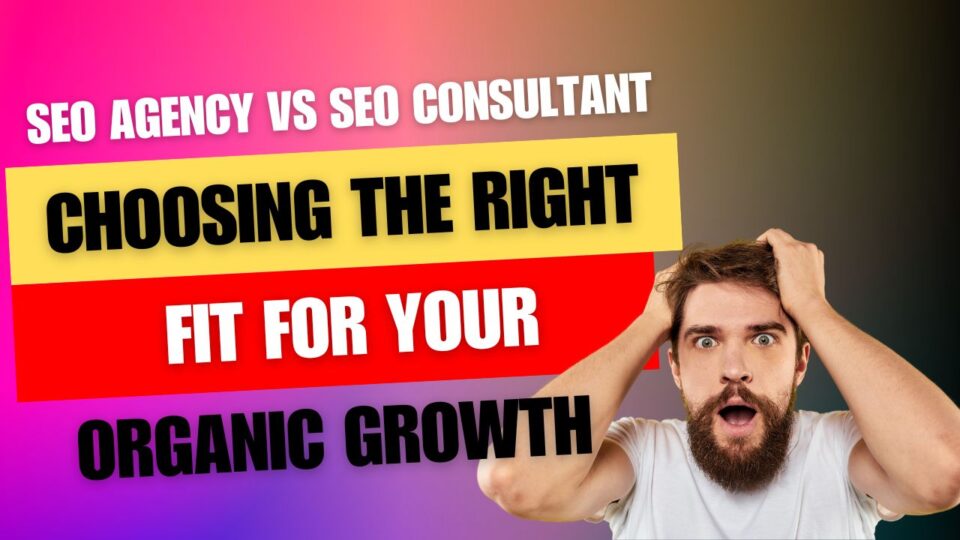- Call/Whatsapp
- +91 7737956466
- sales@jagdishprajapat.com

Mastering Keyword Research: The Key to SEO Success
April 24, 2023
ChatGPT vs. Bard : Exploring the Key Differences in AI Chatbots
June 1, 2023On-Page Optimization Made Easy: Tips and Tools for Higher Rankings

What is On Page SEO?
As a SEO Expert, I know that having a website is essential for any business or individual looking to establish an online presence. However, simply having a website is not enough – it’s important to ensure that your website is optimized for search engines and user experience. That’s where on-page optimization comes in.
In this blog, I’ll share with you the key elements of on-page optimization and provide practical tips to improve your website’s visibility and ranking on search engine results pages. By implementing these on-page optimization techniques, you can ensure that your website is easily discoverable by search engines and provides a seamless user experience for your visitors.
Optimizing a web page effectively requires crucial elements such as analysis and monitoring.
Analysis involves examining the current state of the page, identifying areas for improvement, and targeting optimization efforts. On the other hand, monitoring helps track the results of on-page optimizations and makes ongoing adjustments to ensure the page remains competitive in search engine rankings.
Ultimately, regular analysis and monitoring improve search engine visibility and drive relevant traffic to the page.
Why Is On-Page SEO Important?
On-Page SEO (also called on-site SEO) is important because it helps search engines understand the content of a web page, and determine how relevant it is to a user’s search query.
By optimizing on-page factors such as content quality, keyword usage, and page structure, webmasters can improve their chances of ranking higher in search engine results pages (SERPs) and driving more relevant traffic to their website.
On-page SEO also helps to improve user experience by making it easier for users to navigate and find what they’re looking for on a website.
Overall, On-page SEO is an essential component of any successful search engine optimization strategy.
Effective On-Page SEO Optimization Techniques to Boost Your Website’s Visibility and Rankings
On-page SEO optimization is a crucial component of any successful online business.
To achieve this, there are three main techniques that fall under on-page SEO optimization: Technical On-Page Optimization, Content Optimization, and Design & User Experience Optimization.
Don’t worry, I’m not going to bore you with jargon and technical details. Instead, I’m going to show you practical tips and strategies that you can use to give your website the boost it needs.
With our help, you’ll learn how to optimize your content to attract both search engines and real people, how to optimize the technical aspects of your site to improve page load speeds and user experience, and how to create a visually appealing and user-friendly website that keeps visitors coming back for more.
So, let’s dive into the world of on-page SEO optimization and take your online business to new heights!
1. Technical On-page Optimization
When it comes to optimizing your website for search engines, one crucial aspect is technical on-page optimization. This involves optimizing various technical elements of your website to improve its search engine visibility and user experience. Let’s take a closer look at some of the key areas of technical on-page optimization.
Website Architecture Optimization – Website structure and organization should be optimized to make it easier for search engines to crawl and index your pages.
Code Optimization – HTML code should be optimized by using proper title tags, meta descriptions, header tags, and image alt text to make it easier for search engines to understand your content.
Speed Optimization – Page load speed is important for both user experience and search engine rankings, so it’s important to minimize file sizes, reduce HTTP requests, and optimize images and videos.
Mobile Responsive Optimization – Mobile optimization is crucial because more and more people are browsing on mobile devices, so it’s important to use responsive design and ensure your site is mobile-friendly.
Structured Date Optimization – Structured data markup can help search engines understand the content and structure of your web pages, which can improve search engine rankings and enhance the display of your website’s content in search engine results pages.
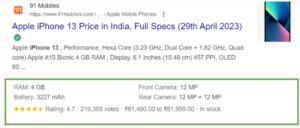
Learn more about the Structured Data Guidelines by Google Search Central.
HTTPS optimization – HTTPS implementation can improve user trust and give a ranking boost in search engine results.
Schema Markeup Optimization – Schema markup is a type of structured data that can improve the way your content is displayed in search engine results, leading to increased click-through rates.
It is a special code that website owners use to help search engines understand what’s on their web pages. For example, on a recipe website, the website owner can add Schema Markup to tell the search engine that this is a recipe page and what information is available, such as the recipe name, ingredients, cooking time, and even reviews from other people who have tried the recipe.
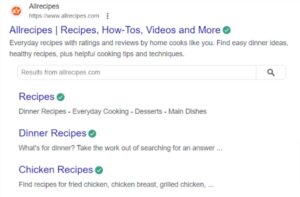
Sitelink Markup
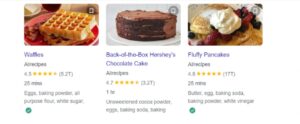
Canonical Tag optimization – Canonicalization helps avoid duplicate content issues and ensures that search engines index the correct version of your page.
Let’s say you have two versions of the same page on your website, one at https://www.example.com/page and another at https://example.com/page. Without canonicalization, search engines might see these as two separate pages with identical content, which can lead to confusion and negatively impact your search engine rankings. By using a canonical tag to specify the preferred version of the page, you can signal to search engines that these pages are actually the same and should be treated as such. This can help consolidate your page authority and improve your search engine rankings.
Sitemap Optimization – XML sitemap optimization can help improve search engine crawling and indexing of your site by making it easier for search engines to crawl and index your site.
XML sitemaps are not designed to be viewed by humans, as they are written in a structured format that is optimized for search engines and other automated tools to crawl and index your website. They typically include a list of URLs for the pages on your website, along with additional metadata such as the last modified date and priority level.

However, some web developers may choose to create a visual sitemap that is designed specifically for human visitors to help them navigate the site more easily. These visual sitemaps may include a graphical representation of the site’s hierarchy and navigation structure, along with clickable links to each page.
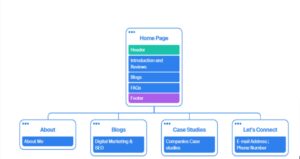
Image Optimization – Image optimization, 404 error page optimization, and caching optimization are important technical aspects of on-page optimization that can greatly improve website performance, user experience, and search engine rankings.
- Image optimization involves compressing and optimizing images to reduce their file size without sacrificing quality. This can help to improve page load speeds and reduce bandwidth usage, which can be particularly important for users on slower internet connections or mobile devices.
- 404 error page optimization involves creating a customized error page that provides users with helpful information and options in case they encounter a broken link or a page that no longer exists. A well-designed 404 error page can help to improve user experience and keep visitors on your site, rather than bouncing back to search engine results.
- Caching optimization involves optimizing the server and browser caching settings to reduce page load times. This can help to improve user experience by reducing the amount of time it takes for pages to load, and it can also reduce server load and bandwidth usage, which can lead to cost savings and better scalability.
Overall, these technical optimization techniques can help to improve website performance, user experience, and search engine rankings, which are all important factors in achieving online success.
Check out these helpful resources that can assist you in measuring, monitoring, and optimizing your page experience and Core Web Vitals for improved search engine rankings and user engagement.
2. Content Optimization
One key to improving your website’s search engine rankings is creating high-quality content that both captivates your audience and impresses search engine algorithms. But it’s not just about creating any content – it’s about optimizing that content to be relevant, informative, and engaging. Following are some key strategies for optimizing your content to help boost your website’s search engine rankings. So, let’s dive in!
- Conduct keyword research to identify relevant keywords to include in the content.
- Use a keyword research tool to identify the most searched for and relevant keywords for your website.
- Strategically place them throughout your website’s content, including the title tag, meta description, and header tags to improve click-through rates in search engine results.
- Use header tags (H1, H2, H3, etc.) to break up your content into smaller sections and make it easier to read.
- Write high-quality, informative, and engaging content that provides value to your target audience.
- Include internal links to other relevant pages on your website to provide additional information to your readers and help search engines understand the structure of your website.
3. Design and User Experience Optimization
Design and User Experience Optimization is crucial for any website or online platform, as it directly impacts how users interact with your content. A well-designed website not only attracts users but also keeps them engaged, resulting in a higher conversion rate.
- Navigation optimization – A website with clear and concise navigation helps users find what they are looking for, reducing the bounce rate and increasing the average session duration. Ensure the website is visually appealing.
- Call-to-action optimization – Implement user-friendly forms and opt-ins for lead generation to capture user information and build an email list. By strategically placing call-to-action buttons throughout the website, you can guide users towards the desired action, such as making a purchase or filling out a contact form.
- Optimize images and videos for fast loading speed to improve user experience and search engine rankings.
- Make use of whitespace and formatting to improve readability and help guide the user through the content.
5 Simple Tips for Creating a Visually Appealing and User-Friendly Website
If you’re looking to create a visually appealing and user-friendly website that keeps visitors coming back for more, then I’ve got 5 best tips that can help.
- Choose a clean and modern design for your website. Avoid cluttered layouts and busy backgrounds that can make it difficult for visitors to navigate your site. A clean and modern design can make your website look professional and up-to-date.
- Use high-quality images that are optimized for web use. High-quality images can add visual interest to your website and help to convey your brand’s message. Make sure the images you choose are relevant to your content and don’t slow down your page load times.
- Make sure your site is mobile-friendly. With more and more people accessing the internet on their mobile devices, it’s essential that your website is optimized for mobile use. Use a responsive design that adjusts to different screen sizes and test your site on multiple devices to ensure it looks great on all of them.
- When it comes to navigation, keep it simple and intuitive. Use clear and concise menu labels and avoid using too many submenus. Simple and intuitive navigation can make it easy for visitors to find what they’re looking for on your website.
- Lastly, choose readable fonts that are easy on the eyes. Sans-serif fonts, like Arial or Helvetica, are often preferred for online use because they are clean and easy to read on screens. Avoid using fonts that are too small or difficult to read.
Following these simple tips, you can create a visually appealing and user-friendly website that will keep visitors coming back for more. Remember, a website that is easy to navigate and visually appealing can help to build trust with your audience and ultimately lead to more conversions and sales.
Implementing these on-page optimization techniques, webmasters can improve search engine visibility, drive relevant traffic to their website, and provide a better user experience for visitors.
This can lead to increased online presence, more visitors, and ultimately, more conversions and sales. On-page optimization is a crucial component of any successful online business, and by implementing these techniques, webmasters can stay ahead of the competition and attract a loyal user base.
Top 5 Tips for Creating High-Ranking SEO-Optimized Content:
- Know your audience: Understand their needs and questions before creating content.
- Research keywords: Use tools like Google Keyword Planner and add them naturally to your content.
- Make it easy to read: Use short sentences, simple words, and clear headings to improve readability. You can use free tools to check if your content is easy to read. These tools include Hemingway Editor, Readable, Grammarly, Yoast SEO, and WebFX Readability Tool.
- Use structured data: This helps search engines understand your content better and improves its appearance in search results.
- Create valuable content: Engage your audience with comprehensive, informative, and engaging content. Avoid spammy tactics like keyword stuffing.
For those seeking additional information on creating impactful content, I recommend reviewing Google Search Central’s documentation- “Creating helpful, reliable, people-first content” provides valuable guidance.
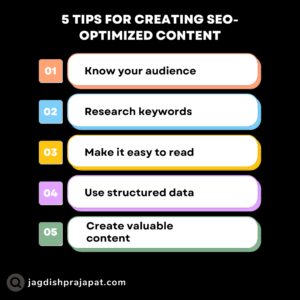
5 Advanced On-Page Optimization Tactics
As an SEO professional, I’m constantly looking for ways to improve my clients’ search engine rankings and drive more traffic to their websites. While basic on-page optimization techniques like Content Optimization , Technical Optimization and Design & User Experience Optimization are important, sometimes they’re simply not enough to get the job done. That’s where advanced on-page optimization tactics come into play.
Advanced on-page optimization tactics are more complex and require a deeper understanding of technical SEO.
- Semantic keyword optimization: In addition to optimizing for primary keywords, you can also use semantic keywords and related terms to improve the relevance and context of your content.
- Video optimization: Optimizing your website’s videos for search engines can help improve their visibility in search results and attract more traffic to your website.
- AMP optimization: Accelerated Mobile Pages (AMP) is a technology that helps improve the speed and performance of your website’s pages on mobile devices, providing a better user experience and potentially improving your search engine rankings.
- Voice Search Optimization: As voice search continues to grow in popularity, optimizing your website for voice search can help improve your rankings and attract more traffic. Use natural language and long-tail keywords to optimize for voice search queries.
- Featured snippets are the highlighted boxes of text that appear at the top of search engine results pages (SERPs) in response to certain search queries.
To target featured snippets, you need to identify relevant keywords that trigger featured snippets and create high-quality content that provides a direct and concise answer to the user’s query. Use structured data markup, such as schema.org, to help search engines understand the content and format it in a way that is easy to digest for users.
Additionally, using lists, tables, and other formatting techniques can also help increase the chances of your content appearing as a featured snippet. Monitor your website’s performance and adjust your content and formatting as needed to increase the likelihood of appearing as a featured snippet.
On-Page SEO Checklist
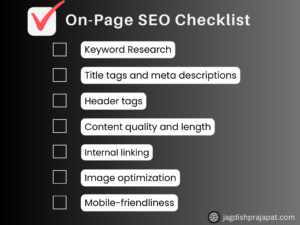
- ✓ Keyword research: Use tools like Google Keyword Planner to identify relevant keywords and phrases to incorporate into your content.
- ✓ Title tags and meta descriptions: Write clear, concise, and descriptive title tags and meta descriptions that include your target keywords.
- ✓ Header tags: Use header tags (H1, H2, H3) to structure your content and make it easier to read. Include your target keywords in at least one header tag.
- ✓ Content quality and length: Create high-quality, informative, and engaging content that provides value to your audience. Aim for at least 500-700 words per page.
- ✓ Internal linking: Include internal links to other relevant pages on your website to help users navigate and improve the overall user experience.
- ✓ Image optimization: Optimize your images by compressing them, using descriptive file names, and adding alt tags with relevant keywords.
- ✓ Mobile-friendliness: Ensure your website is mobile-friendly and provides a positive user experience on all devices.
Best Tools for On-Page Optimization
On-page optimization tools can help you improve your website’s performance and visibility in search results. Here are some popular tools to consider, each with their own unique features and capabilities.
Google PageSpeed Insights: A free tool that analyzes your website’s performance and provides suggestions for improving page speed. It provides valuable insights into what is slowing down the website, and offers suggestions on how to improve page speed and user experience. By using PageSpeed Insights, website owners can make necessary adjustments to optimize their site’s performance, resulting in faster loading pages and a better user experience.
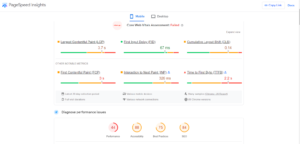
Google Search Console: This tool helps you monitor and improve your website’s presence in Google search results. You can see search analytics data, fix indexing issues, and receive alerts about potential problems.
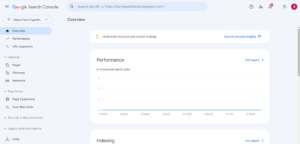
SEMrush: A comprehensive suite of SEO tools that includes keyword research, site audit, backlink analysis, and more. SEMrush offers a free trial with limited functionality.
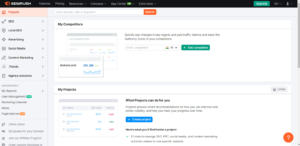
Moz Pro: Another suite of SEO tools that includes site audits, keyword research, link analysis, and more. Moz Pro also offers a free trial with limited functionality.
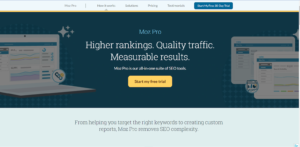
Screaming Frog: Screaming Frog is a popular on-page optimization tool that crawls your website and provides you with a detailed analysis of your website’s structure, metadata, content, and URLs. It can identify issues like broken links, duplicate content, missing titles, and other on-page SEO issues. The tool is available for free for up to 500 URLs, with a paid version available for larger websites.
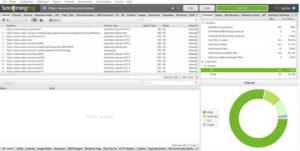
Ahrefs: Ahrefs is a comprehensive SEO tool that includes on-page optimization features, such as the ability to analyze your website’s backlink profile, keyword rankings, and competitor analysis. It can also help you identify on-page SEO issues like broken links, missing alt tags, and duplicate content. The tool offers a 7-day trial for $7, with a paid version available for ongoing use.
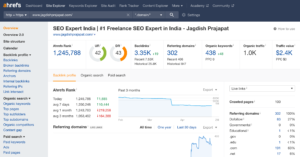
Need help optimizing your website for SEO?
As an experienced SEO consultant, I can work with you to develop a customized strategy that meets your business goals and objectives. Let me help you achieve success online with my professional SEO services. Schedule a consultation and take the first step towards better search engine visibility.
Conclusion
On-page optimization is crucial for improving your website’s search engine rankings. Keyword research, title tag optimization, meta description optimization, heading tag optimization, image optimization, content optimization, URL optimization, and internal linking are some of the essential on-page optimization techniques. By implementing these techniques, you can ensure that your website ranks well on the SERPs and attracts potential customers.
In conclusion, remember that on-page optimization is an ongoing process, and it is essential to keep updating your website regularly to maintain its rankings. By following these techniques, you can improve your website’s search engine rankings, drive more traffic, and increase your business’s visibility. So, start optimizing your website today and reap the benefits of on-page optimization!


